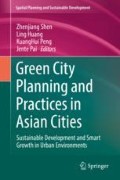Abstract
To continuously increase urban space, it is quite unlikely for mountain cities to be able to expand their boundaries. With the lack of natural, ecological land resources and the unrecyclable nature of such resources, the only way out for them is to make the most of their existing resources and to find a new development mode that focuses on the internal renewal of those cities. As one of the largest mountain cities in Western China, faced with a series of grave problems in city development such as economic remodeling, functional updating, and resource reorganization, Chongqing is taking a development tactic focusing on optimizing and integrating resources, which may become a good model for other mountain cities in the same region. In view of the characteristics of the natural ecological and land resources in the mountain cities, the urban design tactics for these cities emphasize two aspects. The first is constructing hierarchical and systematic natural resource protection mechanisms, strengthening the dominant position and restrictive role of natural elements in the mountainous urban landscapes and maintaining the urban spatial texture of cluster growth; at the same time, in light of urban industry restructuring, exploiting the functions and tapping the potentials of the riverside belt as an urban landscape area open to the public, seeking a new model which is fit for the development of the riverside belts in cities. The second is taking resource integration as the main approach to efficient use of the land resources in downtown areas and by constructing three-dimensional public pedestrian systems in the cities, combining the cultural landscape and commercial facilities with urban street spaces so as to save these spaces from isolation; and by forming a compact, land-efficient, and multifunctional urban pattern, which is at the same time adapted for the various transport modes, shifting the mountain cities from an old pattern towards a new, intensive, resource-rich, and economizing pattern.
References
Abbott C, Xu WT (1997) The metropolitan frontier: cities in the modern American West. Commercial Press, Beijing
Chen H-l (2004) Human geography. Science Publishers, Beijing
Chen G-J et al (2003) The report of mountainous area in China. Commercial Publishers, Beijing
Hou B-z (2005) City transformation: cycle, strategy and mode. Urban Plann Forum 2005(05):1–11. 16
Huang G-Y (2002) Mountain city science. China Building Industry Publishers, Beijing
Li Y (2006) Urban renaissance and experience from Cardiff, UK. Urban Plann Overseas 2006(02):23–28
McHarg IL, Rui J-W translated (1991) Design with nature. China Building Industry Publishers, Beijing
Mo T-W, Mo H-Z (2005) Market, bazaar, trading, the behaviour of living form: on the ability in bringing back living activity. Time Archit 2005(02):16–21
Qiu B-x (2005) Urban planning reform during the urbanization in China. Tongji University Press, Shanghai
Zhu D-J, Yi H (2005) Research on the basic theory of urban planning in China based on integrated courses. Urban Plann Forum 2005(01):21–23
Author information
Authors and Affiliations
Corresponding author
Editor information
Editors and Affiliations
Rights and permissions
Copyright information
© 2018 Springer International Publishing AG, part of Springer Nature
About this chapter
Cite this chapter
Lu, F., Jiang, M. (2018). Ecological and Intensive Design Tactics for Mountain Cities in Western China: Taking the Main District of Chongqing as an Example. In: Shen, Z., Huang, L., Peng, K., Pai, J. (eds) Green City Planning and Practices in Asian Cities. Strategies for Sustainability(). Springer, Cham. https://doi.org/10.1007/978-3-319-70025-0_6
Download citation
DOI: https://doi.org/10.1007/978-3-319-70025-0_6
Published:
Publisher Name: Springer, Cham
Print ISBN: 978-3-319-70024-3
Online ISBN: 978-3-319-70025-0
eBook Packages: Earth and Environmental ScienceEarth and Environmental Science (R0)

